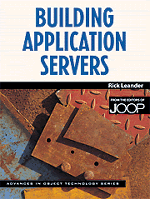Book contents
- Frontmatter
- Contents
- acknowledgements
- Introduction
- PART 1 ARCHITECTURE
- PART 2 DESIGN
- Chapter 3 Designing Application Servers
- Chapter 4 Service Interface Design
- Chapter 5 Designing Business Objects
- Chapter 6 Designing the Persistent Object Layer
- Chapter 7 Integrating Existing Systems and Legacy Software
- PART 3 PROGRAMMING
- Appendix: Setting up a Development Environment
- Index
Chapter 6 - Designing the Persistent Object Layer
from PART 2 - DESIGN
Published online by Cambridge University Press: 06 July 2010
- Frontmatter
- Contents
- acknowledgements
- Introduction
- PART 1 ARCHITECTURE
- PART 2 DESIGN
- Chapter 3 Designing Application Servers
- Chapter 4 Service Interface Design
- Chapter 5 Designing Business Objects
- Chapter 6 Designing the Persistent Object Layer
- Chapter 7 Integrating Existing Systems and Legacy Software
- PART 3 PROGRAMMING
- Appendix: Setting up a Development Environment
- Index
Summary
Just as the service interface layer connects the application server to user interface programs, the persistent object layer connects the application server to databases, object stores, and other external applications. Once the business objects perform the processes requested by the service interface, the resulting data must be stored for later use. The persistent object layer routes this data to relational databases or other forms of long-term storage.
In the business environment, data is most often stored in relational databases. Although there are other persistence alternatives, such as object database management systems (ODBMS) that directly store and retrieve objects, these are products that are just now starting to move into the mainstream. Relational database is a mature technology that has been refined over 25 years, and business data processing relies heavily on this technology. For the application server to fit into the business environment effectively, the persistence layer must bridge application server objects with the relational data model.
A number of methods can be used to implement persistent objects, and many of these will be explored in this chapter. Depending on the size and scope of the application server project, these methods can range from a simple set of collections, each representing similar business objects, all the way to a comprehensive persistence service that acts as an object broker, handling persistence, life cycle, and directory services for the entire application server.
- Type
- Chapter
- Information
- Building Application Servers , pp. 129 - 156Publisher: Cambridge University PressPrint publication year: 2000



